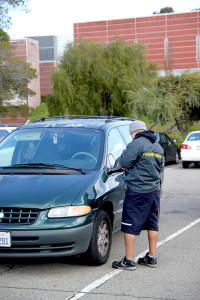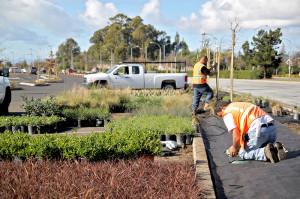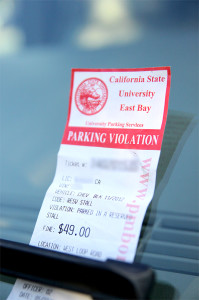CSUEB Parking Fines Total Hundreds of Thousands

tickets per week, most costing
recipients $49.
Got a parking ticket on campus? Well, if you paid that ticket you contributed to a pool of money worth hundreds of thousands of dollars each year.
In the fiscal year 2011, parking citation and forfeiture fees accounted for $375,000 in revenue for CSU East Bay.
So far in the fiscal year 2012, essentially from July through November, tickets have already racked up $119,000.
Most tickets issued on campus cost the recipient $49, which covers a variety of parking infractions. Other offenses, such as parking in a space reserved for people with disabilities, can cost much more.
Once a ticket is paid, the university contracts the Parking Management Bureau, which is run out of CSU Stanislaus, to process it. They keep a small percentage of each fee paid.
The dispute process can also affect how much money is returned to the university. A written online dispute is the first step in the process, but if the plaintiff is unhappy with the parking official’s judgment, that person can request an administrative hearing and possibly even a county court hearing. Generally, the less levels involved in a dispute, the more money the university keeps from each citation, instead of paying small fees to the county or other organizations.
However, the money that does make it back to CSUEB is not used for paying utility costs, buying computers or for professor salaries.
Due to California State University Education code, money collected from parking fines and forfeitures must “…be used exclusively for the development, enhancement, and operation of alternate methods of transportation programs for students and employees, for the mitigation of the impact of off-campus student and employee parking in university communities, and for the administration of the parking fines and forfeitures programs.”

refreshed landscaping are funded through permit
sales.
At CSUEB, roughly $200,000 of that money is funding the TransMetro shuttle service on campus, which transports thousands of students and staff to and from the Hayward BART station every month.
The shuttle program, which recently added a 40-passenger coach bus and expanded its hours, is also partially funded by two Alameda County Transportation Commission regional grants totaling $148,400. According to Mark Almeida, associate director of parking for CSUEB, the school is also looking into expanding the shuttle service for weekend service once or twice a month, which will aid students and staff who attend Saturday classes, and residents on campus who wish to have better access to public transit.
Another avenue for those substantial ticket funds is a new vanpool program the university is testing for staff and faculty who live in the Tracy, Stockton, Manteca and Modesto areas. It consists of two shuttles that leave the Tracy park and ride, and arrive on campus, one at 7 a.m. and another at 8:30 a.m. They both depart the campus eight hours after arrival. In the first year of it’s operation, the university is picking up the tab to the tune of $26,000, plus the price of gas, roughly $1,000 per month. After the initial year, riders would pay a fee to use the service.
Derrick Lobo, Cal State East Bay parking services coordinator, says the rate of ticket writing for parking services is significantly lower than in 2009, when parking services took over those responsibilities from University Police. He said it seemed to take people a while to catch on to the idea that parking was going to be enforced on campus in a comprehensive way. Lobo says roughly 100 tickets are being written a week, currently.
 “With as much as we’ve been enforcing over the last two years, it still amazes me that there are that many people out there that don’t get the permits,” he said. “But, on the other hand, it is funding our shuttle now, which is helping a lot of other students, to provide us with that free shuttle. So at least that money is going to a good cause.”
“With as much as we’ve been enforcing over the last two years, it still amazes me that there are that many people out there that don’t get the permits,” he said. “But, on the other hand, it is funding our shuttle now, which is helping a lot of other students, to provide us with that free shuttle. So at least that money is going to a good cause.”
If the citation money steadily dries up, however, the administration would be left with a funding shortage for programs like the student shuttle.
“We’d have to figure that out,” said Brad Wells, Vice President of administration and finance at CSUEB. “We don’t have other sources of funds that could be used for alternative transportation programs, except for parking in some limited fashion.”
One of the constant gripes of students all over campus is the lack of parking during peak hours, but Lobo stressed that there has only been one day in recent years where parking was actually over capacity. He says that most days, the first thing to go is parking closest to the school, and that is where students spend much of their time searching for spots. Parking lots near the baseball field, such as N and P, rarely fill up.
A recent revised university master plan included plans for a $25 million parking structure to be placed in front of Meiklejohn Hall, where the old practice soccer field resides. However, the entire master plan is held up in litigation, and the Supreme Court of California, according to Wells, will eventually hear the case, but there is no set date.
In order to help pay for that structure, permit fees were raised from $95 to $130 in the fall of 2010. The increase led parking services to increase the citation amount to the current $49 from the previous $30. Lobo said that without a price increase, students would more often take the chance of not buying a permit, as even acquiring four tickets at the lower price would be cheaper than a permit per quarter.
“The whole point is we don’t want to give tickets on campus, we would prefer that everyone just buy their permit,” said Lobo.
“If you were to buy a permit, we can take that money and use it for a lot more things, we can use it to build infrastructure, we can use it to clean up the roads or fix areas that need work, which we can’t use the citation moneys for,” he added.
Some of the improvements funded by permits include the recent repaving and repainting of the back lots, as well as the current landscaping improvements being installed.
For 2011, the university sold roughly 7,500 permits in the fall, 7,000 in the winter, and 6,900 in the spring.
Lobo says there are no plans to raise permit prices anytime soon, but there are also no plans to lower the prices.














